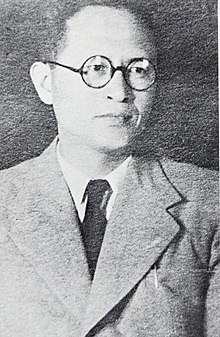| Chu Yong-ha | |
|---|---|
 | |
| Vice Chairman of the Workers' Party of Korea Central Committee | |
| 1st Central Committee | |
| In office 30 August 1946 – 9 September 1948Serving with Kim Il Sung | |
| Chairman | Kim Tu-bong |
| Minister of Transportation | |
| In office 9 September 1948 – October 1948 | |
| Premier | Kim Il Sung |
| Preceded by | Post established |
| Succeeded by | Pak Ui-wan |
| Personal details | |
| Born | 1908 (1908) |
| Nationality | Korean |
| Political party | Workers' Party of Korea |
| Korean name | |
| Chosŏn'gŭl | 주영하 |
| Hancha | 朱寧河 |
| Revised Romanization | Ju Yeongha |
| McCune–Reischauer | Chu Yŏngha |
Chu Yong-ha (Korean: 주영하; Korean pronunciation: [tsu.jʌŋ.ɦa]; 1908 – ?) was a North Korean politician and diplomat. Chu was elected into several posts in the Workers' Party of North Korea, the predecessor of the Workers' Party of Korea, in its early days. Chu was the target of plots ensuing from factional strife within the party. As a member of the Domestic faction, Chu was opposed by the Guerrilla, Soviet and Yan'an factions.
During the Korean War, Chu was North Korea's ambassador to Moscow. After the war, a fictitious plot against Kim Il Sung was "uncovered" in a show trial. Among the claims against the defendants was overthrowing Kim Il Sung and making Pak Hon-yong the new premier, and Chu one of his vice-premiers.
Biography
Chu was born in 1908.
Chu was part of the Political Committee of the Workers' Party of North Korea that was founded in August 1946 as a compromise between rivaling factions of communists on the orders of the Soviets. Chu represented the Domestic faction in the newly formed party.
In the First Congress of the party on 28–30 August 1946, Chu was elected to the Political Committee (Politburo) of the first Central Committee of the party. On the same occasion, Chu was elected vice-chairman of the Secretariat of the party. Chu presided over the session on 30 August. In addition, Chu was elected vice-chairman of the party, along with Kim Il Sung in the first plenum of the Central Committee on 31 August.
In the Second Congress of the party, 27–30 March 1948, Chu was re-elected to the Political Committee of the second Central Committee. Chu presided over the session on 27 March. Chu was re-elected vice-chairman in a plenum of the second Central Committee on 31 March. Chu compromised with the Kim Il Sung faction, but remained a supporter of Pak Hon-yong. In September 1948, when the Democratic People's Republic of Korea (North Korea) was officially proclaimed, Chu was appointed to the Minister of Transport in the North Korean Cabinet headed by Premier Kim Il Sung. In the third plenum of the second Central Committee, on 24–25 September 1948, Ho Ka-i replaced Chu as the vice-chairman of the party as well as the chairman of the inspection committee.
The organ of the North Korean government, Minju Choson, criticized Chu for defending former members of the Workers' Party of South Korea who had stayed in the North. Kim Il Sung's Guerrilla faction, together with the Soviet and Yan'an factions, sought to remove Chu as well.
During the Korean War, Chu was the North Korean ambassador to Moscow.
In the show trial of Ri Sung-yop and 12 other defendants in August 1953 just after the end of the Korean War, a fictitious conspiracy was revealed. According to the accusers, the conspirators planned overthrowing Kim Il Sung and making Pak Hon-yong the premier. Chu was to accompany Chang Si-u as Pak's vice-premiers.
See also
References
- 주영하 [Chu Yong-ha]. Encyclopedia of Korean Culture (in Korean). Retrieved 12 December 2015.
- Jürgen Kleiner (1 January 2001). Korea, a Century of Change. World Scientific. p. 276. ISBN 978-981-279-995-1.
- ^ Alexander Kim (January 1970). "Soviet Policy in North Korea". World Politics. 22 (2): 252. doi:10.2307/2009863. JSTOR 2009863. S2CID 154760833.
- Suh 1988, p. 77.
- Kim 1999, p. 66.
- Suh 1988, p. 75.
- Kim 1999, p. 73.
- Kim 1962, p. 146.
- 北韓組閣完了(북한조각완료) 동아일보 1948-09-11 1면
- Suh 1988, pp. 92–93.
- Kim 1962, p. 180.
- Glenn D. Paige; Dong-jun Lee (June 1963). "The Post-War Politics of Communist Korea". The China Quarterly. 14: 20. doi:10.1017/S0305741000020993. S2CID 154816371.
- Zhihua Shen (2012). Mao, Stalin and the Korean War: Trilateral Communist Relations in the 1950s. Routledge. p. 242. ISBN 978-0-415-51645-7.
- Lankov, Andrey (January 2002). From Stalin to Kim Il Sung: The Formation of North Korea, 1945–1960. C. Hurst & Co. Publishers. pp. 94–95. ISBN 978-1-85065-563-3.
Works cited
- Kim, Yong-mok (1962). The Korean Labor Party and the North Korean Regime. University of California, Berkeley.
- Kim, Soo-min (1999). Political Legitimization in North Korea: 1945–1950. University of Hawaii.
- Suh, Dae-sook (1988). Kim Il Sung: The North Korean Leader (1st ed.). Columbia University Press. ISBN 0-231-06573-6.
- 1908 births
- Ambassadors of North Korea to Russia
- 20th-century Korean diplomats
- Government ministers of North Korea
- Vice Chairmen of the Workers' Party of Korea and its predecessors
- Members of the 1st Central Committee of the Workers' Party of North Korea
- Members of the 2nd Central Committee of the Workers' Party of Korea
- Members of the 1st Political Committee of the Workers' Party of North Korea
- Members of the 1st Standing Committee of the Workers' Party of North Korea
- Members of the 2nd Political Committee of the Workers' Party of Korea
- Members of the 2nd Standing Committee of the Workers' Party of Korea
- Members of the 1st Supreme People's Assembly